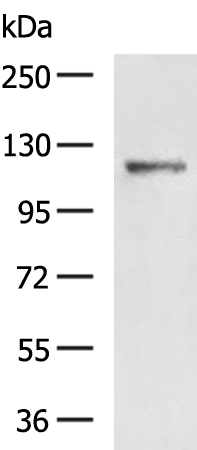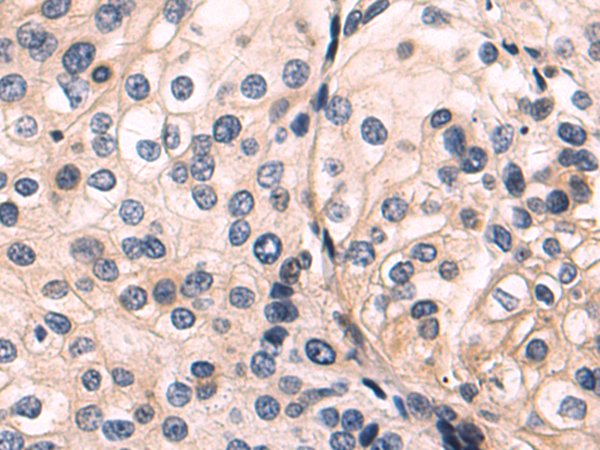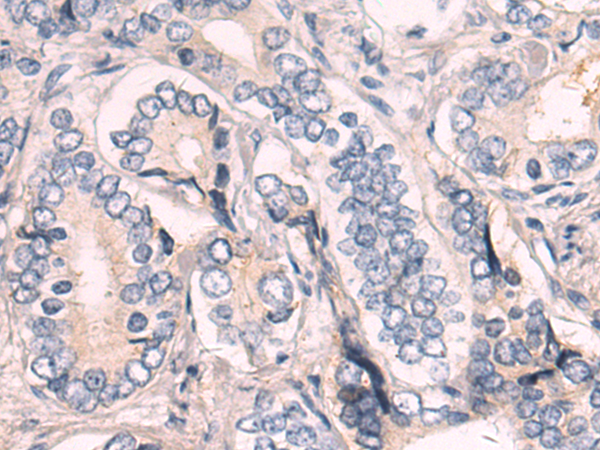


| WB | 咨询技术 | Human,Mouse,Rat |
| IF | 咨询技术 | Human,Mouse,Rat |
| IHC | 1/100-1/300 | Human,Mouse,Rat |
| ICC | 技术咨询 | Human,Mouse,Rat |
| FCM | 咨询技术 | Human,Mouse,Rat |
| Elisa | 1/5000-1/10000 | Human,Mouse,Rat |
| Aliases | LIG1; LIG-1 |
| WB Predicted band size | 119 kDa |
| Host/Isotype | Rabbit IgG |
| Antibody Type | Primary antibody |
| Storage | Store at 4°C short term. Aliquot and store at -20°C long term. Avoid freeze/thaw cycles. |
| Species Reactivity | Human, Mouse |
| Immunogen | Synthetic peptide of human LRIG1 |
| Formulation | Purified antibody in PBS with 0.05% sodium azide and 50% glycerol. |
+ +
以下是关于LRIG1抗体的3篇参考文献,包含文献名称、作者和简要摘要内容:
---
1. **文献名称**: *LRIG1 inhibits EGFR signalling in glioblastoma stem-like cells*
**作者**: Nilsson J, et al.
**摘要**: 该研究利用LRIG1特异性抗体,发现其在胶质母细胞瘤干细胞中通过促进EGFR降解抑制EGFR信号通路,表明LRIG1可能作为肿瘤抑制因子调控肿瘤生长。
2. **文献名称**: *LRIG1 expression in prostate cancer and its correlation with clinical outcomes*
**作者**: Stenqvist M, et al.
**摘要**: 通过免疫组化分析前列腺癌组织中的LRIG1蛋白表达,发现低表达LRIG1与肿瘤高分级和不良预后相关,提示其作为潜在生物标志物的价值。
3. **文献名称**: *Antibody-based detection of LRIG1 extracellular domain in colorectal cancer*
**作者**: Hedman H, et al.
**摘要**: 研究开发了一种针对LRIG1胞外结构域的单克隆抗体,验证其在结直肠癌中的表达模式,发现LRIG1高表达患者的总生存期显著延长,可能与抑制肿瘤转移有关。
---
以上研究均利用LRIG1抗体探索其在癌症中的作用机制或临床意义。如需具体期刊或年份信息,可进一步补充关键词检索。
LRIG1 (Leucine-rich repeats and immunoglobulin-like domains 1) is a transmembrane protein belonging to the LRIG family, which includes LRIG2 and LRIG3. It is characterized by leucine-rich repeats (LRRs) and immunoglobulin-like domains in its extracellular region. LRIG1 functions as a tumor suppressor by negatively regulating receptor tyrosine kinases (RTKs), such as EGFR family members, through promoting their ubiquitination and degradation. This regulatory role impacts cell proliferation, differentiation, and survival, linking LRIG1 to cancer biology and tissue homeostasis. Reduced LRIG1 expression is observed in various cancers, including glioblastoma, breast cancer, and squamous cell carcinoma, and its loss often correlates with poor prognosis.
Antibodies targeting LRIG1 are essential tools for studying its expression, localization, and interactions. They are widely used in techniques like Western blotting, immunohistochemistry (IHC), immunofluorescence (IF), and flow cytometry. These antibodies help elucidate LRIG1's tissue-specific distribution, its dynamic regulation during pathological processes, and its interplay with signaling pathways. Some antibodies specifically recognize extracellular epitopes, enabling the study of LRIG1's ligand-binding properties, while others target intracellular domains for functional assays.
Researchers also utilize LRIG1 antibodies to explore its role in stem cell biology, as LRIG1 marks stem cell populations in tissues like the epidermis and intestine. Validation of antibody specificity, species cross-reactivity (human, mouse, rat), and compatibility with experimental models (e.g., formalin-fixed vs. frozen samples) remains critical for reliable data. Commercial LRIG1 antibodies are available from multiple suppliers, often with distinct validation profiles.
×